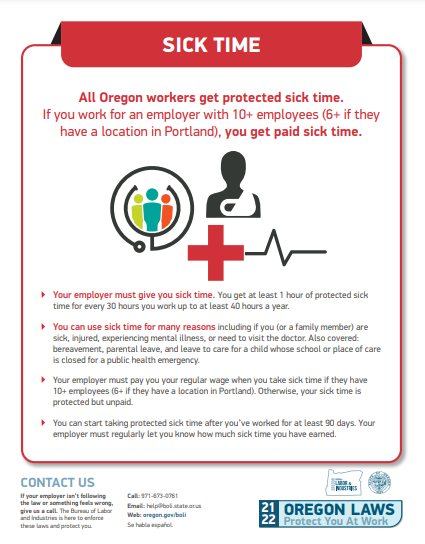Every business in Oregon—even those with just one employee—is subject to the Oregon sick leave law, which requires up to 40 hours of sick time off per employee during a year. The sick leave may be paid or unpaid, depending on the size and location of your company. Even if your company is not located in Oregon, but you have a remote employee who lives and works in Oregon, then you are subject to this law.
Key Takeaways:
- Oregon’s paid sick leave must be provided if you have 10 or more employees (six or more if your business operates in Portland). If your workforce is smaller, sick time is protected but unpaid.
- Employees in Oregon earn one hour of sick time for every 30 hours worked in a year. However, the maximum sick time they can earn is only 40 hours per year.
- Your employees can start accruing sick leave on their first day of employment with your company but they can only use it after working for 90 calendar days.
- You must update employees on their earned sick time credits at least every three months.
What Is Oregon’s Sick Leave Law?
The Oregon sick leave is part of a set of Oregon labor laws that cover the state’s working conditions, compensation standards, and employment rules. In addition to federal labor laws, if you have a business or employees working in Oregon, you must comply with the state’s labor regulations.
Under the sick leave laws in Oregon, you are required to give employees protected sick time of at least one hour for every 30 hours worked per year Based on the Oregon sick leave law, the year pertains to any consecutive 12-month period. This can be a calendar year, fiscal year, contract year, or any other 12-month period the employer customarily uses. —but capped at 40 hours of earned sick time annually. With Oregon sick time considered as protected time, employees are allowed to be absent from work without disciplinary actions or the threat of potentially losing their jobs, provided the reason for the sick leave is included in the law’s qualified absences.
Employees can use earned sick time to care for themselves or eligible family members in times of sickness, injury, mental illness, and other valid reasons like going to the doctor for diagnosis. For a list of the qualified absences, check out the Oregon Sick Time Allowed Uses section.
Paid & Unpaid Sick Time
While all Oregon businesses and employers with remote team members working in this state must provide Oregon sick leave, it can only be considered as paid leave for those with 10 or more workers (or six or more employees if the business is in Portland). Businesses that don’t meet this requirement still have to offer Oregon sick leave but as unpaid time off.
Some companies’ staff numbers may fluctuate—especially seasonal businesses that don’t have full-time workers year-round. If this fits your company, you need to calculate your daily average worker count over any 20-week period in the previous year. If your company has a daily average of 10 or more employees (again, six or more in Portland), then your workers are entitled to paid sick leave.
PTO vs Sick Leave
For easier time-off management, some companies combine their paid time off (PTO) and sick leave into one policy. You can do that so long as your PTO policy meets the requirements for Oregon’s law on sick days. This does not exempt you from providing other leave benefits that may be required under Oregon or federal law.
Sick Time Entitlement & Eligibility
Oregon sick time accrual begins when an employee starts working for an employer. They can accrue one hour of sick time for every 30 hours worked—so if they work full-time for you throughout the year, they are likely to earn almost 70 hours of sick time.
However, under Oregon’s sick time laws, you are only required to allow employees to utilize 40 hours of their earned sick time annually. Plus, your new employees can only use their accrued sick time after working for 90 calendar days.
If an employee didn’t use any accrued sick time, this can be carried over to the next year. Note that the Oregon sick leave law allows you to limit the carry-over amount to up to 40 hours per year, with a total accrual balance cap of 80 hours. However, the carry-over rule doesn’t apply if you use the front-load method.
Eligible Employees
Nearly all employee types—full-time, part-time, and seasonal—are entitled to Oregon sick leave. However, you’re not required to provide sick leave for the following:
- Independent contract workers
- Employees who receive paid sick time under the Family and Medical Leave Act (FMLA)
- Employees who are either a parent, spouse, or child of the business owner
- Workers participating in a federal or state work training program
- Employees participating in a work-study program
- Railroad workers exempt under the federal Railroad Unemployment Insurance Act
Oregon Sick Time Allowed Uses
Your employees may use their earned Oregon sick leave to care for themselves or eligible family members, such as parents, grandparents, spouse or domestic partner, children, siblings or stepsiblings, and grandchildren. It can also be used for non-medical related reasons.
Below are the qualified absences:
- Seek treatment or recover from a health condition that renders the employee unable to perform at least one of the essential functions of the job
- Recover from injury, mental/physical illness, or a health condition
- Go to doctor appointments for diagnosis, preventive medical care, or treatment
- Care for an infant, newly adopted child, or newly placed foster child under 18 years of age; this also includes disabled children over 18 years old
- Care for a child whose school or daycare is closed for a public health emergency
- Absences related to the death of a family member
- Absences related to domestic violence, harassment, sexual assault, bias, or stalking
- Absences related to the closure of the employee’s workplace due to a public health emergency
Employee Separations
When an employee leaves your company, you do not have to pay out any accrued and unused sick time, unless you have an Oregon sick time policy explicitly stating that you pay out sick time when an employee leaves. Whatever your company policy, you must follow it every time.
Calculating Oregon Sick Pay
You must pay employees taking sick leave their regular rate of pay, provided you meet the requirements for the Oregon paid sick leave. For hourly employees, if they only receive one rate of pay, then you’ll need to pay them their regular hourly rate for every hour they take sick leave. If the hourly employee has more than one rate of pay, use the weighted average of their rates of pay.
Salaried employees must be paid the total wages earned during their sick leave. For example, your employee, Sarah, receives a weekly salary of $2,500, and she took one day of sick leave. You’d then need to pay her $2,000 of regular wages, plus $500 for the one day she took sick time off.
If you have commissioned employees who do not receive a base pay, then you need to pay them at least minimum wage for every hour of sick time they take off. For commissioned employees who do receive a base pay, you must pay them the rate equivalent to their hourly rate or minimum wage, whichever is greater.
While overtime, bonuses, tips, and other pay beyond an employee’s base rate do not contribute to computing Oregon sick pay, shift differential pay does apply, so you need to ensure you’re calculating correctly if you have employees who fall into that category.
Employer Requirements
Beyond providing sick time off to your Oregon workers, you need to keep accurate records of your employees’ sick time accrual and usage, provide them with information about their rights, and give them regular updates about their sick time balance.
Sick Time Balance Statements
Oregon sick leave law requires employers to provide employees with at least quarterly statements showing the amount of sick leave they have accrued and used. You can make this information available anywhere and, if you use payroll software, you can include this calculation with every pay stub, meeting the law’s requirements.
Notice & Posting
Placing compliance posters in conspicuous places around your workplace is part of ensuring compliance with employment and HR laws. For Oregon, its required worksite posters include the one for Oregon sick time, which contains information about the employee’s basic sick leave rights.

Oregon sick time poster in English (Source: Oregon Bureau of Labor & Industries)
When you have remote workers, you can post a notice on your company intranet, electronic bulletin board, or even release companywide email notices. If you send a regular internal newsletter, it’s a good idea to include a link to required labor law posters with each newsletter, along with any other compliance requirements.
Asking for Documentation
Be careful about asking for proof that an employee was out sick or caring for an ill family member. While it may seem prudent to require documentation when an employee takes sick leave, according to Oregon sick time laws, you can only do so in the following circumstances:
- If an employee has been out for more than three consecutive working days.
- If an employee’s sick time is foreseeable (e.g., surgery or scheduled medical treatment) and will be longer than three consecutive working days.
- If an employee commences sick time but doesn’t provide adequate or reasonable notice as required by your company’s sick time policy—which may not be more than 10 days of advance notice if sickness is foreseeable or more notice than is practical or reasonable for unforeseeable sick leave, according to Oregon law.
- If you have a legitimate reason to question the employee’s use of sick leave, such as excessive absenteeism or abuse of sick time.
Legal Considerations
Oregon’s sick time law is fairly straightforward but still requires attention to detail so you don’t fall out of compliance. If you calculate pay incorrectly or violate an employee’s rights under the law, you could face fines and penalties from the state, as well as employee lawsuits.
Fines & Penalties
Failing to properly pay wages, including sick time and final pay, to an employee may result in a penalty wage, which is up to eight times the employee’s regular rate of pay. Even innocent payroll mistakes can lead to this overwhelming fine.
Oregon also allows for a fine of $1,000 per violation. So, if you have three employees who take sick time, but your payroll team fails to properly calculate their sick time pay, not only will your company owe those employees eight times their regular rate of pay for each hour of sick time, but you’ll also owe the state $3,000 in fines.
Using the example above, let’s say one of those employees took four hours of sick time. It will be calculated as such:
Rate of pay: $14.50 per hour
Unpaid sick hours: 4 hours
Sick hour pay owed to employee: $14.50 × 4 = $58
State-imposed penalty rate: $58 sick hour pay owed to employee × 8 = $464
In this instance, you’d owe the employee $464 for four hours of unpaid sick time, plus owe Oregon a $1,000 fine. Violating this law adds up rapidly.
Employee Lawsuits
Oregon levies harsh penalties for employers who willingly or innocently violate the sick leave law. Employee lawsuits can get even more costly for companies, both financially and reputationally.
When an employee takes sick time off, don’t retaliate against them, harass them, discipline them, or fire them. Taking any of these actions could lead to an employee lawsuit for harassment or wrongful termination.
If they have taken lots of time off or they’ve abused other policies, you may have a legitimate reason to question an employee’s use of sick time off. But, make sure you document these concerns to be sure you have proof of a legitimate concern.
Consistency & Record-keeping
As with all HR-related matters, keep detailed records. Make sure you stay compliant with the law by providing a record of each employee’s accrued and used sick time at least quarterly. Also, keep any records relating to an employee’s sick time off. Because these records are medical, however, you’ll need to keep them away from the employee’s regular personnel file and put them in a confidential file with limited access.
Be fair and consistent with your sick leave policy both in the amount of time you provide, but also in how you react to employees taking leave. Remember—what you do for one employee, you need to do for all.
Frequently Asked Questions (FAQs) About Oregon Sick Leave
No, but Oregon sick time is normally used in hourly increments. If your company’s sick leave policy allows taking sick time in increments lower than one hour, then this is allowed. However, I don’t recommend it because it makes tracking sick leave balances harder for you or your HR team.
No, you are still required to offer Oregon sick time to workers covered by the CBA. However, you can also comply with Oregon law if the CBA includes a sick leave or paid time off program that is equivalent to or more generous than the state’s sick time policy.
You can request a document that certifies that the employee was hospitalized or will undergo medical treatment if the absence is three or more days—but you can’t require the employee to provide a certification that explains the illness, medical diagnosis, or treatment plan. Similarly, you may not require workers who use Oregon sick leave for absences related to domestic violence, sexual assault, harassment, or stalking to provide a verification document that shows full information about the incident.


